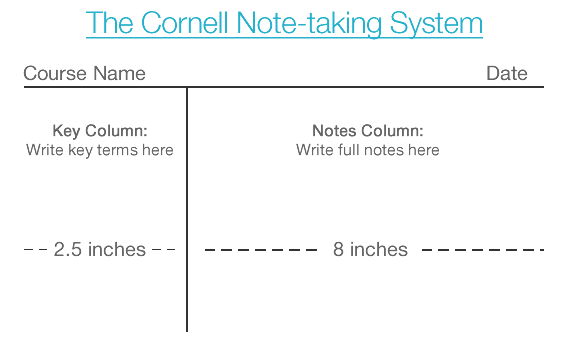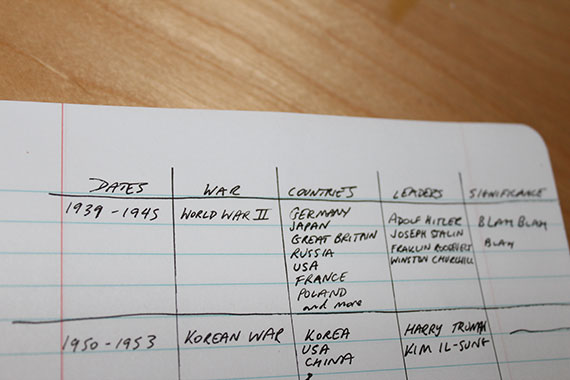How to take notes effectively
Note-taking skills and methods for exam prep
The way in which you take notes can have a big impact on your academic success. Effective notes enable you to capture the important points of a lecture, organize information, focus your attention on what to study, make it easier to review material, and save your time. Note-taking is based on the premise that no matter how well you pay attention in class, you cannot remember everything the professor said. In any case, note-taking is a perfect way to stay awake and focused during class!
General note-taking guidelines
No matter which note-taking style you decide to follow, a few simple strategies will produce more effective results. Date your notes and number the pages, if using loose leaf paper. Keep your notes brief. Do not try to write every word the professor says. Use phrases instead of sentences. Use words instead of phrases. However, some information should be recorded exactly. This includes definitions, quotations, formulas, and specific facts. If you miss any key words, phrases, reasons, or details, leave some space to fill in the information later. Also, make sure to copy everything that is written on the board. If the professor took the trouble to write something on the board, it’s a clear sign that the information is important.
Sit where you can see the board and hear the professor. This will help keep you focus on the lecture, and away from other students in class or more interesting sights outside the window. Listen for any information that the professor repeats or emphasizes. Especially, look out for numbered clues such as two aspects, three characteristics, four reasons, etc. Also pay attention to the reviews and summaries of lectures made by your professor.
Experiment with various note-taking systems to see what works best for you. Learn common abbreviations to enable you to write quickly, such as w/ for with, w/o for without, = for equals, and so on. Develop your own abbreviations or symbols for commonly used words in a particular subject. Indicate, through arrows, highlighting or underlining, what concepts, relationships, or examples are most important. Write clearly enough for your notes to be legible. Avoid wasting time rewriting your notes. Check with other students if you “tuned out” during the lecture or missed critical words, definitions, or examples.
Keep your notes well-organized and in order. Use a separate notebook for each subject. Avoid using 3-subject or 5-subject notebooks for different subjects. Alternatively, use dividers and loose-leaf paper in a three-ring binder. Review your notes regularly. In the few minutes before each class begins, go over the notes from previous lectures. At the end of each week, glance through your notes to review what you have covered to date.
Note-taking Systems
Outlining
Outlining is a common way to summarize large quantities of information in a logical way. There are many ways to outline, some of which include letters, numbers, Roman numerals and so on. However, the easiest method involves outlining by placing the most important information to the extreme left, with points and subpoints being indented further in. The traditional outline would look something like this:
- TITLE
- I. Heading
- Main Idea
- 1. Supporting Idea
- 2. Supporting Detail
- a. Subdetail
- b. Subdetail
Outlining is most appropriate when making notes from textbooks, where you have time to consider the relationships among different types of information. When reviewing before the test, it is helpful to check whether you can reproduce the outline. However, it is very difficult to use this system while taking notes in class.
The Cornell Note-taking System
The Cornell System is a popular way of taking notes, which enables you to record the main information during the lecture and to make observations and notes related to the information, after the lecture.
To take notes according to this system, divide your paper in the following way: Draw a vertical line one third of the way from the left hand side of the page. During the lecture, take the main notes during the lecture in the area to the right of this line. Try to collect the main points and don’t worry about outlining or classifying at this stage.
After class, make observations and notes about the main content in the area to the left of the line. Write down key words, phrases, expressions, or cues to summarize the info. If there is space, you could also write in questions to help you review the material later.
The advantage of this method is that it encourages you to interact with the new material after class by drawing relationships, identifying key concepts, highlighting key definitions and so on. By reading over your material and working with it in this way, you will be able to understand the larger context in which the new information fits in. The Cornell System is also helpful when reviewing for tests and exams. You can cover the right side of the page, look only at the key words and try to restate the information and examples in your own words.

The Mapping Method
Mapping is a way of taking notes through graphic representation. By making connections between facts, ideas and details, mapping improves your concentration, demands your active participation and sharpens your critical thinking abilities. Instead of seeing pages and pages of words in your notebooks, you will start seeing diagrams, maps, arrows, circles, colors and other coding and classification devices.
Mapping affords several benefits to the student. It enables you to see the big picture and the connections and relationships between aspects of a topic. Being strongly visual, it is easier for you to recall. It can also be an excellent tool for reviewing material before a test or exam. You simply try to reproduce the chart or map and check what’s missing. You could actually use this method to create a diagrammatic review of your entire course, for example, on a roll of brown paper. By putting this up in your room and looking over it, you would be reinforcing your memory easily and frequently.
Example:

The Charting Method
For certain types of distinct information, the charting method can prove useful. By drawing and labeling columns in advance, you can record relevant information into the appropriate category. This not only reduces writing time, but also enables you to summarize and compare information easily and quickly. When reviewing before an exam, you can reproduce the chart which summarizes the key points related to vast amounts of information.
Example:

Take the time to experiment with various note-taking methods and choose the ones that work best for you. You may end up selecting a different method for different subjects, based on the nature of the material to be recorded. And that’s just fine.


Are there other note-taking systems?